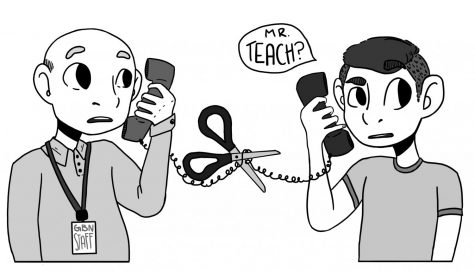Drawing lines of communication

Text messages. Group chats. Emails. From schedule updates to homework questions, it only takes a few taps for students to contact teachers outside of school. When teachers need to send quick alerts to classes, clubs or teams, the convenience of digital conversation is unmatched. But one ill-advised message has the potential to cross the boundary from professional to unprofessional conduct between staff members and students.
Currently, the advised methods of communication vary across athletics, academics and student activities. The athletics department has recently recommended coaches utilize email or group messaging applications such as GroupMe and Remind rather than text messages to communicate with student athletes. In academic conversations with teachers, it has been suggested that one-on-one communication be conducted over email or in person only. The acceptable options for communication in student activities between students and club sponsors include Google Classroom, text messaging and group message applications.
While most teachers adhere to these suggested means of communication with their students for academic notifications or the sharing of scheduling information, the inherent potential for messages to be misunderstood or to overstep should not be overlooked. That is not to say all digital exchanges between students and teachers are improper. Actually, many students find support and mentorship as a result of their bonds with the faculty. There is a healthy level of personal connection that can occur between students and faculty in school, but with unmonitored digital contact, there is no guarantee of appropriate conduct between staff members and students. It may inconvenience students and staff to limit conversation to school email accounts and group messaging apps, but using methods of communication more readily accessible to the school administration promotes our safety.
When adults in the school share their cell phone numbers with students, an unnecessary line of communication is opened, threatening the barrier between school and home life when email could be used instead. Whether it be through the use of Glenbrook North email accounts, Google Classroom updates or another mass notification service, faculty should only contact students for the purpose of school-related information. Students should rely solely on email or face-to-face conversations with staff members.
The athletic department’s recent effort to discourage contact between students and staff over text messages is a well-guided step in more clearly defining the boundaries of student-teacher relationships. The implementation of these new rules will help to ensure our well-being as we focus on our education.

